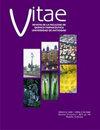Effects of Solar Drying on the Structural and Thermodynamic Characteristics of Bee Pollen
Q3 Pharmacology, Toxicology and Pharmaceutics
引用次数: 0
Abstract
Background: Bee pollen is a natural product collected and transformed by bees, intended for human consumption, given its nutritional and bioactive richness. The fundamental operation of adequacy is drying, which allows its preservation, avoiding chemical or microbiological degradation, typically using tray dryers with hot air that use electricity or fuel for heat generation. Solar drying is an alternative that uses radiation as an energy source. However, it should be ensured that this type of process guarantees the quality of the product while not degrading its properties and, therefore, maintaining its morphological integrity. Objective: to establish the effect of solar drying on bee pollen structure compared to the conventional cabin dehydration process. Methods: Bee pollen was dehydrated using two types of dryers: a solar dryer and a forced convection oven. The solar dryer operating conditions were an average temperature of 19-35 °C with a maximum of 38 °C and average relative humidity (RH) of 55 %. Cabin dryer operating conditions were a set point temperature of 55 ± 2 °C and 10 % RH average humidity. The morphologic and thermodynamic properties of dried bee pollen, such as phase transition enthalpy through Differential Scanning Calorimetry (DSC), porosity and surface area through surface area analysis, and microscopic surface appearance by Scanning Electron Microscopy (SEM), were measured. Results: The results showed dry bee pollen, both in the cabin dryer and solar dryer, did not suffer morphological changes seen through SEM compared to fresh bee pollen. Moreover, surface area analysis indicated the absence of porosity in the microscopic or macroscopic structure, demonstrating that solar or cabin drying processes did not affect the specific surface area concerning fresh bee pollen. Additionally, Differential Scanning Calorimetry (DSC) and Thermo Gravimetric Analysis (TGA) showed that endothermic phase transitions for dried bee pollen by cabin or solar dryer were at 145 °C and 160 °C, respectively. This can be mostly associated with free water loss due to the morphological structure preservation of the material compared to fresh bee pollen. Conclusion: These results demonstrate that solar drying is a reliable alternative to bee pollen dehydration as there were no effects that compromised its structural integrity.太阳干燥对蜂花粉结构和热力学特性的影响
背景:蜂花粉是一种由蜜蜂采集和转化的天然产物,具有丰富的营养和生物活性,供人类食用。充足性的基本操作是干燥,这允许其保存,避免化学或微生物降解,通常使用热风托盘干燥机,利用电力或燃料产生热量。太阳能干燥是一种利用辐射作为能源的替代方法。然而,应该确保这种类型的工艺保证产品的质量,同时不降低其性能,从而保持其形态的完整性。目的:比较太阳能干燥与常规舱脱水工艺对蜂花粉结构的影响。方法:采用太阳能干燥机和强制对流烘箱两种干燥机对蜂花粉进行脱水。太阳能干燥机的工作条件为平均温度19 ~ 35℃,最高38℃,平均相对湿度55%。客舱干燥机的工作条件为设定点温度为55±2℃,平均湿度为10% RH。通过差示扫描量热法(DSC)测定了干燥蜂花粉的相变焓,通过表面积分析测定了蜂花粉的孔隙率和比表面积,通过扫描电镜(SEM)测定了蜂花粉的微观表面形貌和热力学性质。结果:结果表明,干燥的蜂花粉,无论是在机舱干燥器和太阳能干燥器中,与新鲜蜂花粉相比,通过扫描电镜观察没有发生形态学变化。此外,表面积分析表明,在微观和宏观结构中没有孔隙,这表明太阳能或舱内干燥过程对新鲜蜂花粉的比表面积没有影响。差示扫描量热法(DSC)和热重分析(TGA)表明,舱式干燥机和太阳能干燥机干燥蜂花粉的吸热相变温度分别为145℃和160℃。与新鲜蜂花粉相比,由于材料的形态结构保存,这主要与自由水损失有关。结论:这些结果表明,太阳能干燥是一种可靠的替代蜂花粉脱水,没有影响其结构完整性。
本文章由计算机程序翻译,如有差异,请以英文原文为准。
求助全文
约1分钟内获得全文
求助全文
来源期刊

Vitae
PHARMACOLOGY & PHARMACY-
CiteScore
1.20
自引率
0.00%
发文量
0
审稿时长
>12 weeks
期刊介绍:
The journal VITAE is the four-monthly official publication of the School of Pharmaceutical and Food Sciences, and its mission is the diffusion of the scientific and investigative knowledge in the various fields of pharmaceutical and food research, and their related industries. The Journal VITAE is an open-access journal that publishes original and unpublished manuscripts, which are selected by the Editorial Board and then peer-reviewed. The editorial pages express the opinion of the Faculty regarding the various topics of interest. The judgments, opinions, and points of view expressed in the published articles are the responsibility of their authors.
 求助内容:
求助内容: 应助结果提醒方式:
应助结果提醒方式:


